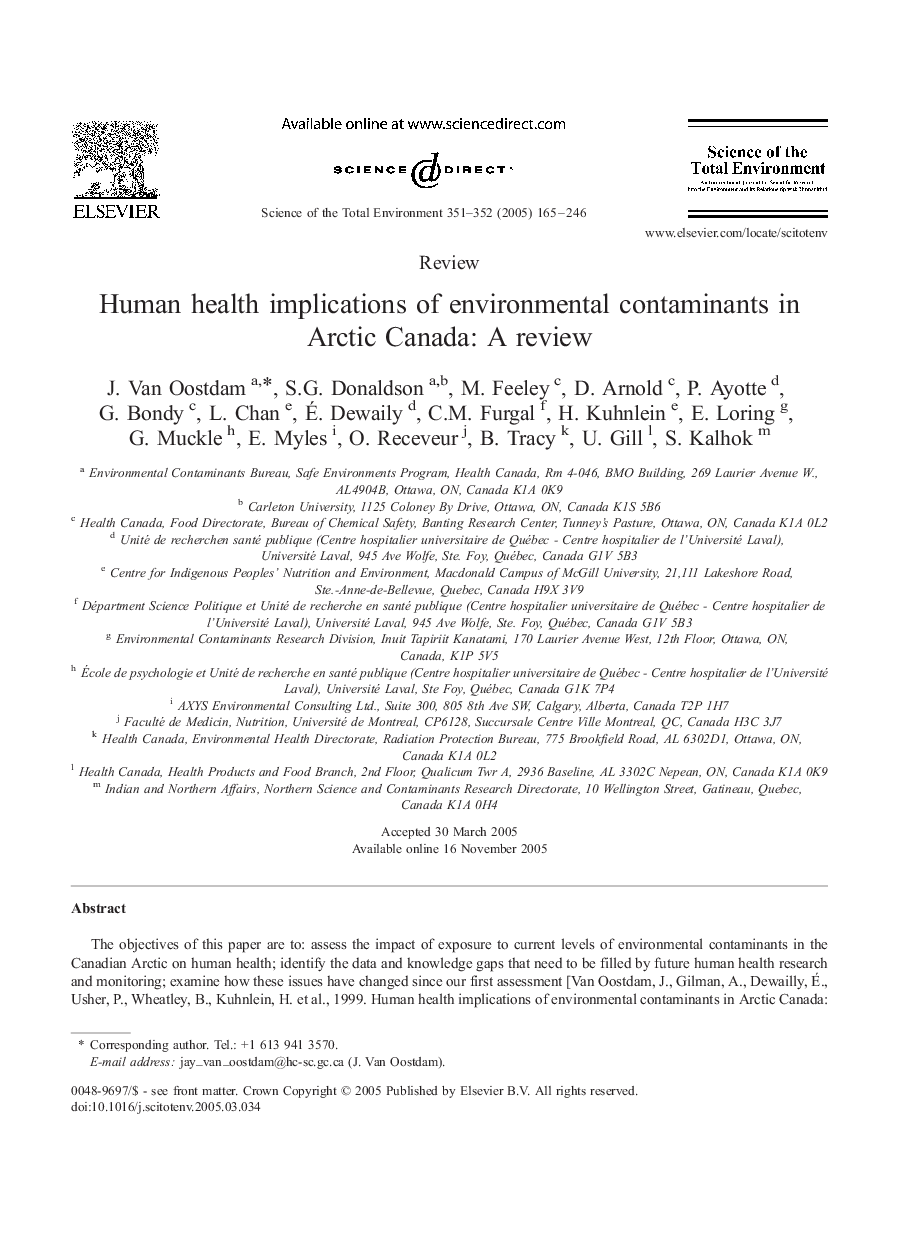| کد مقاله | کد نشریه | سال انتشار | مقاله انگلیسی | نسخه تمام متن |
|---|---|---|---|---|
| 10110567 | 1619987 | 2005 | 82 صفحه PDF | دانلود رایگان |
عنوان انگلیسی مقاله ISI
Human health implications of environmental contaminants in Arctic Canada: A review
دانلود مقاله + سفارش ترجمه
دانلود مقاله ISI انگلیسی
رایگان برای ایرانیان
کلمات کلیدی
موضوعات مرتبط
علوم زیستی و بیوفناوری
علوم محیط زیست
شیمی زیست محیطی
پیش نمایش صفحه اول مقاله

چکیده انگلیسی
The objectives of this paper are to: assess the impact of exposure to current levels of environmental contaminants in the Canadian Arctic on human health; identify the data and knowledge gaps that need to be filled by future human health research and monitoring; examine how these issues have changed since our first assessment [Van Oostdam, J., Gilman, A., Dewailly, Ã., Usher, P., Wheatley, B., Kuhnlein, H. et al., 1999. Human health implications of environmental contaminants in Arctic Canada: a review. Sci Total Environ 230, 1-82]. The primary exposure pathway for contaminants for various organochlorines (OCs) and toxic metals is through the traditional northern diet. Exposures tend to be higher in the eastern than the western Canadian Arctic. In recent dietary surveys among five Inuit regions, mean intakes by 20- to 40-year-old adults in Baffin, Kivalliq and Inuvialuit communities exceeded the provisional tolerable daily intakes (pTDIs) for the OCs, chlordane and toxaphene. The most recent findings in NWT and Nunavut indicate that almost half of the blood samples from Inuit mothers exceeded the level of concern value of 5 μg/L for PCBs, but none exceeded the action level of 100 μg/L. For Dene/Métis and Caucasians of the Northwest Territories exposure to OCs are mostly below this level of concern. Based on the exceedances of the pTDI and of various blood guidelines, mercury and to a lesser extent lead (from the use of lead shot in hunting game) are also concerns among Arctic peoples. The developing foetus is likely to be more sensitive to the effects of OCs and metals than adults, and is the age groups of greatest risk in the Arctic. Studies of infant development in Nunavik have linked deficits in immune function, an increase in childhood respiratory infections and birth weight to prenatal exposure to OCs. Balancing the risks and benefits of a diet of country foods is very difficult. The nutritional benefits of country food and its contribution to the total diet are substantial. Country food contributes significantly more protein, iron and zinc to the diets of consumers than southern/market foods. The increase in obesity, diabetes and cardiovascular disease has been linked to a shift away from a country food diet and a less active lifestyle. These foods are an integral component of good health among Aboriginal peoples. The social, cultural, spiritual, nutritional and economic benefits of these foods must be considered in concert with the risks of exposure to environmental contaminants through their exposure. Consequently, the contamination of country food raises problems which go far beyond the usual confines of public health and cannot be resolved simply by risk-based health advisories or food substitutions alone. All decisions should involve the community and consider many aspects of socio-cultural stability to arrive at a decision that will be the most protective and least detrimental to the communities.
ناشر
Database: Elsevier - ScienceDirect (ساینس دایرکت)
Journal: Science of The Total Environment - Volumes 351â352, 1 December 2005, Pages 165-246
Journal: Science of The Total Environment - Volumes 351â352, 1 December 2005, Pages 165-246
نویسندگان
J. Van Oostdam, S.G. Donaldson, M. Feeley, D. Arnold, P. Ayotte, G. Bondy, L. Chan, Ã. Dewaily, C.M. Furgal, H. Kuhnlein, E. Loring, G. Muckle, E. Myles, O. Receveur, B. Tracy, U. Gill, S. Kalhok,